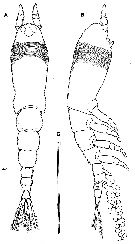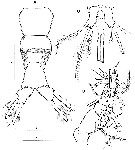|
|
 |
|
Monstrilloida ( Order ) |
|
|
|
Monstrillidae ( Family ) |
|
|
|
Cymbasoma ( Genus ) |
|
|
| |
Cymbasoma striifrons Chang C.Y., 2012 (F) | |
| | | | | | | Ref.: | | | Chang S.Y., 2012 (p.127, Descr.F, figs.F) |  Issued from : C.Y. Chang in Anim. Syst. Evol. Divers., 2012, 28 (2). [p.128, Fig.1]. Female (from 37°27'52.79''N, 129°10'43.41''E): A-B, habitus (dorsal and lateral, respectively); C, ovigerous spines. Scale bar = 500 µm. - Cephalothorax relatively short, 48 % of total body length (from forehead to posterior margin of caudal rami); anterior third swollen laterally. - Anterior part of dorsal surface of cephalic region nearly smooth, except for a pair of sensilla and fine wrinkles near anterior margin of cephalothorax. - Nauplius eye well developed, round in dorsal view, about 0.06 mm in diameter. Ocelli beside naupliuseye round, fairly apart to each other, separated by distance equal to 75 % of eys diameter, about 120 % the diameter of each ocellus, in dorsal view. - Oral papilla lying somewhat anteriorly, o.17 of way back along cephalothorax. Weak wrinkles present around oral papilla and nipple-like processes. - A1 short, relatively stumpy, about 15 % of total body length, and about 31 % as long as cephalothorax. - Cephalothorax 4-segmented, 2nd and 3rd segments not well defined or partly fused; ratio of lengths of segments 13.3 : 28.9 : 14.4 : 43.4 = 100. - Cephalothorax incorporating 1st pedigerous somite. - Urosome 3-segmented (5th pedigerous somite, genital double-somite and anal somite) plus caudal rami; ratio of lengths 32.3 : 40.4 : 27.3 = 100. - Genital double-somite strongly swollen in the anterior half, rather globose, with transverse wrinkles in the middle of dorsal surface and lateral sides of posterior half; outer distal corner not produced. - Ovigerous spines, long and inserted on middle of ventral surface of genital double-somite, basally separated, representing nearly half (49.4 %) of total body length, about 2.7 times longer than urosome, with tips pointed , not swollen, extending slightly beyond tips of caudal setae. - Anal somite trapezoidal, lacking wrinkles or striae both on dorsal and ventral surfaces; lateral margin nearly smooth, without apparent notch. - Caudal rami highly divergent; ramus subquadrate, with slightly concave inner margin, 1.5 times longer than wide; furnished with 2 terminal and 1 lateral setae, subequal in length and breadth. -P5 single lobed, medial margin slightly swollen (representing vestige of endopodal lobe); armed with 3 plumose setae, comprising 2outer subequal in length and breadth, and innermost one smallest and about 1/2 times as long as others.
|
 Issued from : C.Y. Chang in Anim. Syst. Evol. Divers., 2012, 28 (2). [p.129, Fig.2]. Female: A, urosome (dorsal); B, A1; C, P5 and basal part of ovigerous spines (ventral). Scale bars: 100 µm (A,C; 50 µm (B).
|
 Issued from : C.Y. Chang in Anim. Syst. Evol. Divers., 2012, 28 (2). [p.130, Fig.3]. Female: A, cephalic area (ventral); B, P1; C, P4. Scale bars: 100 µm.
|
 Issued from : C.Y. Chang in Anim. Syst. Evol. Divers., 2012, 28 (2). [p.127] . Female: Armature of the swimming legs P1 to P4. Roman numerals indicate number of spines, and Arabic numerals indicate number of setae.
| | | | | NZ: | 1 | | |
|
Distribution map of Cymbasoma striifrons by geographical zones
|
| | | | | | | Loc: | | | S & E Korea | | | | N: | 1 | | | | Lg.: | | | (1095) F: 1,1-1,4; [F: 1,1-1,4]
Body length as usually (excepted for Suarez-Morales) measured from anterior end of cephalothorax to posterior margin of caudal rami (excluding caudal setae). | | | | Rem.: | Inshore.
For C.Y. Chang (2012, p.131), C. striifrons differs from C. rigidum lato sensu by a much smaller body (far less than 2 mm long) and smooth lateral margins of anal somite lacking notch as well as the conspicuous band of transverse striations on the forehead of cephalothorax (as suggested in the specific name). The distinguishable band of transverse striations around the body on the forehead, the decisive character of C. striifrons is shared with only C. striatum (Isaac, 1974) from the English Channel, and Monstrillopsis ferrarii (Suarez-Morales & Ivanenko, 2004) from the White Sea. Besides, C. striifrons is similar to C. striatum in having the character combination of somewhat small body (generally slightly shorter or longer than 1 mm), a single lobed P5 bearing a short, slender medial seta in female, smooth lateral margins of anal somite without notch and wrinkles. However, C. striifrons differs from C. striatum by relatively short cephalothorax (about 48 % of total body length vs. 55 % in C. striifrons, which is somewhat swollen in the anterior third in this new species, rather strongly wrinkled genital somite, and much shorter aesthetasc on the lest segment of A1 (strikingly long, and far exceeding the distal end of the last segment in C. striatum (see Suarez-Morales, 2000).
- C. tumorifrons differs from C. striifrons by a rounded protuberance on the anterior margin of ventral surface, a relatively longer cephalothorax (55 % in C. tumorifrons vs. 45 % in C. striifrons), the number of ventral nipple-like processes on the cephalothorax (2 pairs in C. tumorifrons vs. 1 pair in C. striifrons, and the length ratio between two terminal spines of A1 (subequal in C. tumorifrons vs. about 1.5 in C. striifrons).
- C. quintanarooense differs from C. striifrons by relatively larger body (around 2 mm long), relatively elongated cephalothorax (59 % of total body length), dorsolateral patches of longitudinal striations just behind ocelli, and a round protuberance on ventral anterior margin of genital double-somite. | | | Last update : 16/03/2021 | |
|
|
 Any use of this site for a publication will be mentioned with the following reference : Any use of this site for a publication will be mentioned with the following reference :
Razouls C., Desreumaux N., Kouwenberg J. and de Bovée F., 2005-2025. - Biodiversity of Marine Planktonic Copepods (morphology, geographical distribution and biological data). Sorbonne University, CNRS. Available at http://copepodes.obs-banyuls.fr/en [Accessed October 20, 2025] © copyright 2005-2025 Sorbonne University, CNRS
|
|
 |
 |






